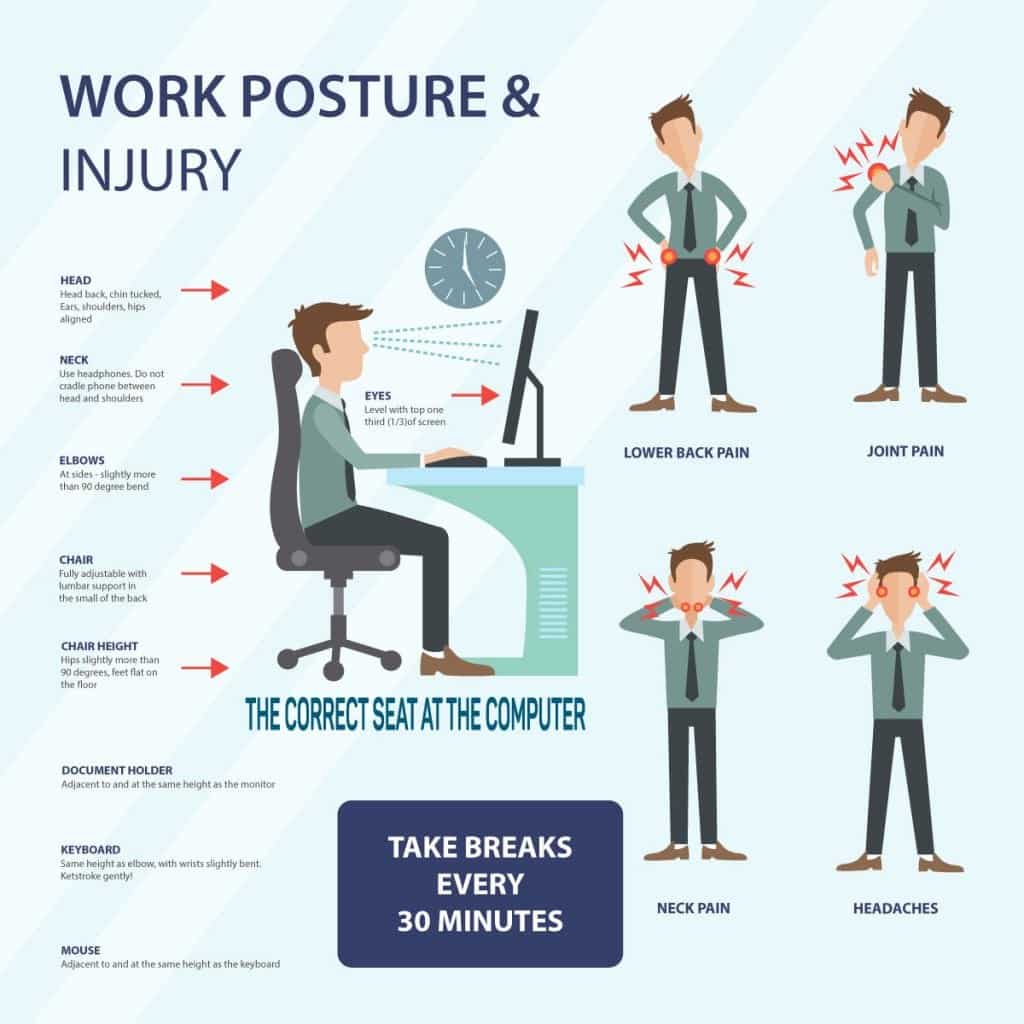Posture and Work Injury
With 90% of the modern work force using personal computers it is becoming ever more important that workers ensure that their workstation is constructed in an ergonomic fashion thus preventing posture and work injury related issues as much as possible.
Ergonomics is the science of fitting workplace conditions and job demands to the capabilities of employees. That is designing the job to fit the worker, instead of forcing the worker to fit the job. In doing so the risk of injury to the worker is minimized and the cost of workplace injuries is reduced.
Most current office based injuries are cumulative rather than traumatic in nature. These conditions occur gradually over a period of time whether that is weeks, months or years. The most common of these conditions are tendonitis, carpal tunnel syndrome, tennis elbow, neck and back injuries, strains/sprains, bursitis, thoracic outlet syndrome and trigger finger.
Symptoms of workplace injuries are wide and varied and can include discomfort, pain, muscle fatigue, swelling, stiffness, inflammation, numbness, tingling, burning sensation, heaviness, weakness or clumsiness in hands.
The likelihood of developing an injury is dependent on the frequency and duration of exposure to risk factors. These risk factors can be summarised into 6 categories:
1. REPITITION
The majority of repetitive strain injuries are caused by repetitive motions that would not normally result in injury but when performed over and over again they result in trauma to the involved tissues
4. VIBRATIONS
Use of tools or equipment that vibrates places stress on the involved tissue and structures.
2. AWKWARD POSITIONS & POSTURES
Incorrect posture increases the stress on the body. Some of the most common postural errors people are guilty of include leaning forward at the desk, typing with the wrist not in a neutral position, elevated shoulders while at the desk, reaching to use the phone or mouse and twisting the neck to use the phone or to look at the monitor.
5. TEMPERATURE
Environmental conditions such as extreme heat or cold can place stress on tissues. Extreme cold constricts blood vessels and reduces sensitivity and coordination of body parts. Excessive heat can result in increased fatigue and heat stress.
3. EXCESSIVE PRESSURE OR FORCE
Force is the amount of physical effort required by a person to do a task or maintain control of tools or equipment. A pinch grip produces 3-5 times more force on the tendons in the wrist than a grip with the whole hand. With excessive force the muscles are contracting much harder than normal, this can lead to stress on the muscles, tendons and joints.
6. PSYCHO-SOCIAL
Stress, boredom, job dissatisfaction and anxiety can increase the chance of developing a repetitive strain injury. Psycho-social issues can create increased muscle tension and reduce a person’s awareness of work technique
Fortunately there are preventative measures and strategies that can be implemented into any workplace to reduce the likelihood of any workplace related injury occurring. These measures include:
- Check lighting, noise and temperature.
- Check work pace and stress levels.
- Avoid leaning forward at your desk
• Maintain natural “s” curve of your spine
• Support lower back
• Keep feet supported on floor or foot rest
• Avoid typing with wrists at an odd angles
• Keep them in the neutral position, not bent up or down, or side to side
- Have the keyboard slightly lower than normal desk height.
• If it is not low enough, try raising your chair height. Prevent your legs from dangling by using a footrest.
- Keep “home row” of keys at elbow level.
- Adjust your chair!
- Keep the elbows at a comfortable angle while “hanging” at the sides from the shoulders. The shoulders should remain relaxed in a lowered position while typing.
- Do not pound the keys. Use a light touch.
- Use two hands to perform double key operations like Ctrl-C or Alt-F instead of twisting one hand to do it.
- Position frequently used equipment so that you don’t have to reach for it.
- Place the monitor in front of you, not off at an angle.
- Take lots of breaks to stretch and relax.
- Hold the mouse lightly.
- Keep your hands and arms warm.
And remember if symptoms such as pain, tingling or numbness in the hands, fingers, feet or toes, loss of strength or coordination in the arms, hands, legs or feet, headaches and neck pain, discomfort or stiffness continues then SEE YOUR CHIROPRACTOR.
Walkley Chiropractic Clinic operates in the following locations. Click the links to find us.

